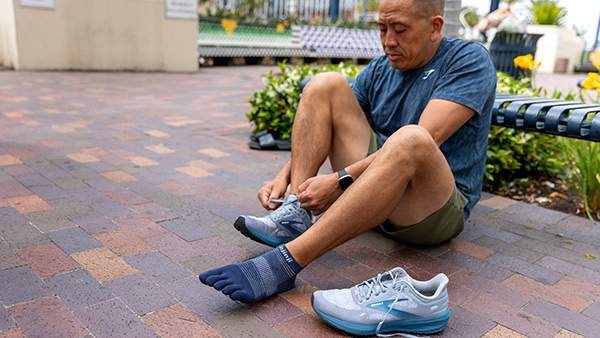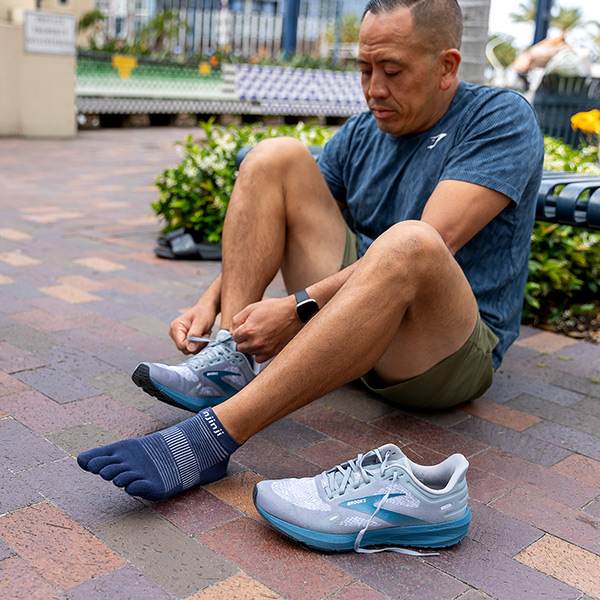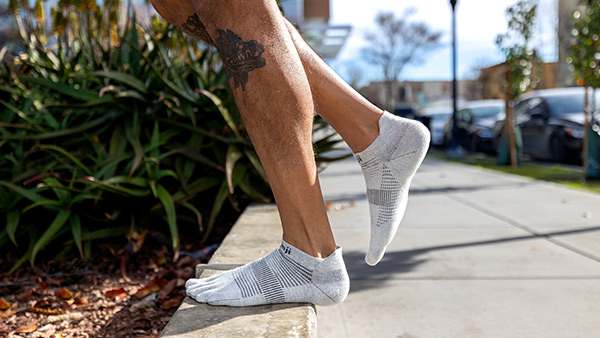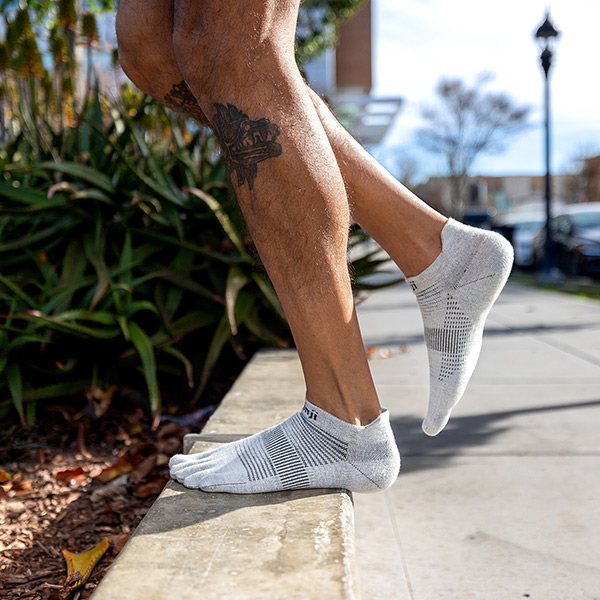Foot injuries can be a frustrating setback for any athlete. While runners often work on building strength in their legs and core, sometimes the importance of strengthening feet is overlooked. Physical Therapist and Team Injinji Athlete Parker Farabee has some valuable insights, research-backed strategies, and practical exercises to help runners build stronger, more resilient feet.
_____
Recently I had to cancel an ultra trail project I was working on. Training was going as planned, I was getting into higher mileage weeks and felt like I was recovering well after running. Then after one tempo run, BOOM, my foot had enough, and I limped home. Turns out my plantar fascia had other ideas about this run, and it was time to rebuild.
Injuries are a part of running. The not fun part, but a part, nonetheless. A quick Google search for “running exercises” will show a combination of planks, squats and lunges to give you a strong core and lots of power. I love leg day, but why do we ignore the lower leg and rely on running shoes and orthotics for foot stability? I dug into the research, so you don’t have to and want to share my findings on foot training.


Recently I had to cancel an ultra trail project I was working on. Training was going as planned, I was getting into higher mileage weeks and felt like I was recovering well after running. Then after one tempo run, BOOM, my foot had enough, and I limped home. Turns out my plantar fascia had other ideas about this run, and it was time to rebuild.
Injuries are a part of running. The not fun part, but a part, nonetheless. A quick Google search for “running exercises” will show a combination of planks, squats and lunges to give you a strong core and lots of power. I love leg day, but why do we ignore the lower leg and rely on running shoes and orthotics for foot stability? I dug into the research, so you don’t have to and want to share my findings on foot training.
The human foot is made up of 33 joints, 26 bones, and 29 muscles. For successful locomotion, your feet must have the right combination of flexibility and stability. Flexibility allows the foot and ankle to move to absorb the force of running, while also being able to stiffen to act as a rigid lever to propel you forward without conscious effort. Ground reaction forces during running can reach up to three times a runner’s bodyweight depending on their sex, speed, mechanics, and other factors. So where do these forces go?


Shoe companies utilize this power to give your shoes more elastic energy: the shoe will absorb the force through stretch or compression, then spring back and help propel you forward. However, this shoe technology has still not achieved full energy return, which means a lot of the ground forces continue up the leg, affecting the ankles, knees, or hips. Over time, this can cause injury.
Aside from trauma from a fall or blow to the foot, running related injuries are often due to the repetitive nature of the activity with forces compounding over time. As your body fatigues during a run, your muscles have a harder time withstanding the impact. To allow your body to continue moving, structures such as tendons, ligaments, and the plantar fascia then take on more force often with painful results. A stronger, better functioning foot will allow the muscles within the foot to reduce impact forces from traveling up the leg during the initial landing phase and will continue efficient forward propulsion during the toe-off phase.
So, how do you get stronger feet? Let them move! If you already have a strength training routine, the easiest way to engage your feet is to take your shoes off. Performing standing exercises such as squats, lunges, deadlifts barefoot (or in your favorite Injinji toesocks) allows your toes, feet, and ankles to move in their natural way and receive effective strengthening. You may also notice that your running mechanics change if you perform jumping exercises or running drills without shoes.


Additionally, there are exercises that target the intrinsic foot muscles, or muscles that only attach within the foot. As you’ll see in the video, exercises like towel scrunches or heel raises with a tennis ball are great examples to get started with.
Don’t miss your next race or event because of an injury. Just ten minutes a day, three days a week of intentional and progressive foot exercise will elevate your running to the next level.
_____
Ready to hit the ground running after working on some foot strength? Grab a pair of Injinji socks and get out there!
_____
Sources:
Matias AB, Watari R, Taddei UT, Caravaggi P, Inoue RS, Thibes RB, Suda EY, Vieira MF, Sacco ICN. Effects of Foot-Core Training on Foot-Ankle Kinematics and Running Kinetics in Runners: Secondary Outcomes From a Randomized Controlled Trial. Front Bioeng Biotechnol. 2022 Apr 14;10:890428. doi: 10.3389/fbioe.2022.890428. PMID: 35497357; PMCID: PMC9046605.
Manganaro D, Dollinger B, Nezwek TA, et al. Anatomy, Bony Pelvis and Lower Limb, Foot Joints. [Updated 2023 Aug 21]. In: StatPearls [Internet]. Treasure Island (FL): StatPearls Publishing; 2024 Jan-. Available from: https://www.ncbi.nlm.nih.gov/books/NBK536941/
Suda EY, Watari R, Matias AB, Taddei UT, Sacco ICN. Predictive Effect of Well-Known Risk Factors and Foot-Core Training in Lower Limb Running-Related Injuries in Recreational Runners: A Secondary Analysis of a Randomized Controlled Trial. Am J Sports Med. 2022 Jan;50(1):248-254. doi: 10.1177/03635465211056329. Epub 2021 Nov 17. PMID: 34786990.
Taddei UT, Matias AB, Duarte M, Sacco ICN. Foot Core Training to Prevent Running-Related Injuries: A Survival Analysis of a Single-Blind, Randomized Controlled Trial. Am J Sports Med. 2020 Dec;48(14):3610-3619. doi: 10.1177/0363546520969205. Epub 2020 Nov 6. PMID: 33156692.
Yu L, Mei Q, Xiang L, Liu W, Mohamad NI, István B, Fernandez J, Gu Y. Principal Component Analysis of the Running Ground Reaction Forces With Different Speeds. Front Bioeng Biotechnol. 2021 Mar 25;9:629809. doi: 10.3389/fbioe.2021.629809. PMID: 33842444; PMCID: PMC802689








